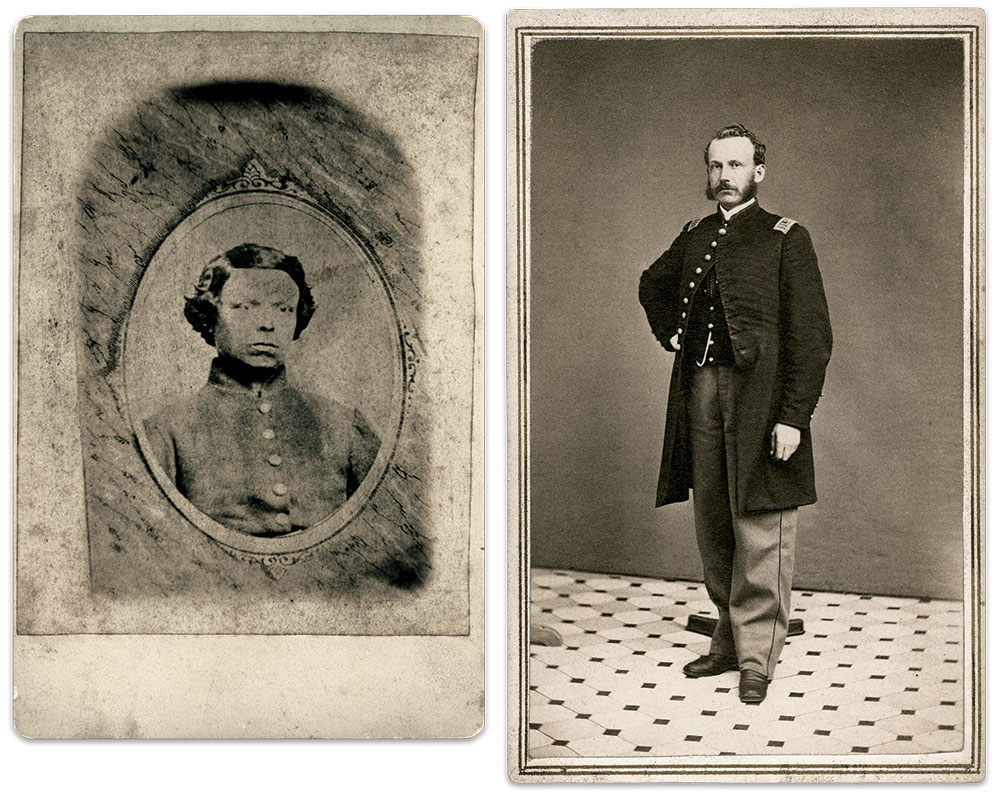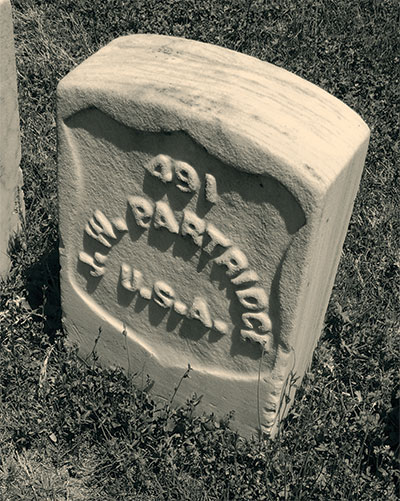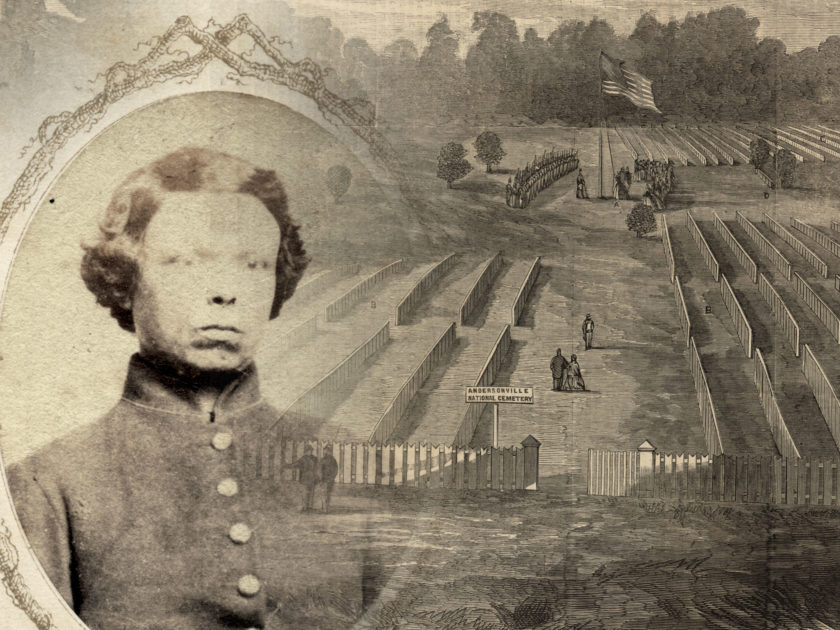By Earvin Lee Joyner, Jr.
The peaceful, serene landscape of the National Cemetery at Andersonville belies the suffering that occurred there some 150 years ago. Visitors to the Georgia site can gaze out upon a white sea of nearly 13,000 marble headstones aligned as men in order of battle. Each marks the final resting place of an individual who suffered and died far from home in the adjacent Union prisoner of war camp. Each marker tells the story of a man who once lived, loved and was cherished by family and friends. Most are lost in the cloudy mists of history.

Nothing sets marker number 491 apart from its neighbors. Beneath this stone lie the remains of John William Partridge. A New England schoolteacher-turned-soldier, his life journey, and those buried around him, ended here.
What sets him apart from many others is a cache of surviving letters he wrote to his family during his time in uniform. Through these letters his voice speaks to us today, a witness to a time of distant conflict.
His journey began in Boylston, Mass., in 1834, when he was born the only son of a church deacon, Simeon Partridge and his wife, Mary. Young Partridge never really knew his mother, for she died after a cooking accident before his second birthday. He did however know and form a tight bond with his step-mother, Sarah, who joined the family soon after Mary’s death.
Partridge grew up, proved a good student and pursued a career as an educator in 1858. Success came easily, and one Boylston historian recalled him as a “promising young teacher.”
Then the war came. In September 1861, Partridge and thousands of his fellow teachers, students and other Bay Staters joined the army. He enlisted as a private in Company D of the 25th Massachusetts Infantry.
Partridge learned the art of war in camp at Worcester, Mass. About this time he posed for this portrait wearing his new uniform. He is also wearing a wig, or toupee. Partridge was probably balding prematurely, as evidenced by at least one wartime reference to taking Dr. Sterling’s Ambrosia, a patent medicine that claimed to be a hair restorative.
Meanwhile, Maj. Gen. Ambrose E. Burnside planned a 12,000-man amphibious strike force to capture key Confederate installations on the North Carolina coast. The 25th joined the expedition in early January 1862. Partridge did not count among them. He, and about 100 others sick with measles and other maladies, remained behind to convalesce. By the time he joined the regiment in February, he missed its first taste of battle on Roanoke Island. But his first opportunity would come soon enough.
On the drizzly and foggy morning of March 11, 1862, he and his comrades landed at New Bern. Among the other blue regiments with them was its brother regiment, the 24th Massachusetts Infantry.
In a letter home written two days later, he recounted, “We proceeded at a rapid march and in about an hour saw our right turning into the woods and forming in line of battle. As our company filed into the woods a gun was fired from the enemy’s battery. The ball fell a few feet from me. It struck the ground without doing any damage. It was probably aimed at our officers who were standing in the road a short distance from us and could be distinctly seen from the enemy’s battery. We filed into the woods to the right of the 24th, and advanced almost in sight of the enemy, but being held in reserve we laid down on the ground. We could hear the roar of the cannon on our left and the sharp quick report of the rifles. At length we were ordered to advance which we did quite continuously and soon we came into an open field in sight of the rebel works. As we advanced a battery opened on us on the right, and our own gun boats taking us for the enemy also opened their fire on us. We fell on our faces as soon as we heard the balls whistle overhead we rose and marched in retreat. We could do no other way as the enemy were before us and on our flank, and we were in danger from our own shells in the rear.”
“We could hear balls as they passed over our heads, and several of the shells from the gun boats exploded in the air over me. The gun boats were quickly informed of their error and they threw their shells higher in the air.”
The 25th retreated apace and hugged the ground. Partridge continued, “We could hear balls as they passed over our heads, and several of the shells from the gun boats exploded in the air over me. The gun boats were quickly informed of their error and they threw their shells higher in the air. We should probably make another attempt to outflank the enemy but orders came for us to support our own battery on the left. The position of companies H and D was directly behind our guns. We lay on the ground a few moments and then came the order to fix bayonets and charge. We rose and started on the run. The rebels fled as we approached. The colors of the 25th were the first to be planted on the enemy’s battery. When we came within the battery we saw several horses that had been shot dead and others still struggling in the harnesses. One fine gray horse tied to a tree had a rifle wound in each foreleg and in one hind leg. Wagons, carts and gun carriages were tipped about in strange confusion. The killed and wounded had mostly been carried away but a few still remained. We soon came on a party of them in the woods. Several rifle balls passed near by us, two coming within a foot of my head. As there was still sharp firing on our left, we did not know but they might be stray shots from our own men, and we advanced cautiously, frequently falling on our faces to avoid the balls.”
Soon, they received orders to stop firing as the enemy had surrendered. The 25th rounded up about 100 prisoners and a rebel flag.
Thus began the occupation of North Carolina for Partridge, who spent much of the next two years maintaining a Union presence in the region. In letters home, he details the many small-scale expeditions and skirmishes, of endless picket and guard duties and other military operations. He also writes of inter-regimental baseball games to pass the time and the ever-present threats of disease.
Partridge proved a keen observer of the contrasts between the black and white populations. He wrote of fine buildings and “negro huts” in New Bern, of concerns about black looters and disloyal white citizens among other subjects.
His letters also suggest that he favored equality for men and women of color. He approved of teaching former slaves to read. On Oct. 2, 1862, he shared his thoughts on the recent announcement of President Abraham Lincoln’s forthcoming Emancipation Proclamation. “We have just got the late proclamation of the President. I think it is just the thing. The conservatives cannot say but that sufficient time is given to the Rebels for repentance and return, and the Radicals can see the good time coming when the niggers will go free.”
In a letter home dated June 21, 1863, Partridge described one former slave he encountered at church.
“I took a seat in the gallery, shortly after a blind yellow man, doubtless once a slave groped his way to a seat opposite me. He was coarsely though decently clad, short, slim and slightly stooping, a rather high and broad forehead, prominent cheek bones, and a small chin, his lips were slightly open displaying his teeth, thick wooly hair about two inches thick on his head, a long slim neck and rather slight frame. His eyes were somewhat sunken and the sockets being rather prominent gave him a slightly hideous aspect, with all he had the appearance of a child of sorrow and suffering.”
Partridge continued, “But whatever he has suffered he seemed to have overcome all sorrow and resentment, if he ever cherished any and to live in a purely spiritual atmosphere. His countenance was calm and spoke of triumph over suffering. He seemed to enter into the exercises with great interest and enjoyment, and at the closing hymn which begins with these words, “Jesus lover of my soul. Let me to thy bosom fly,” the emotions of his soul were too great for suppression, he rose and in a clear, sonorous voice, which sounded above the organs peal and the voices of the choir, sang through the entire hymn, while his sightless eyeballs, turning heavenward, and his whole countenance expressing trust, triumph resignation and love, with the naturally hideous aspect of his countenance, suggested the idea of the angel of light arising from a conflict with the fiends of the bottomless pit, turning as he began to breathe the pure air of his native atmosphere, and calmly surveying the scene of his former conflicts, and then beginning his song of praise for his great deliverance.”
This same month, Partridge applied to join the Signal Corps. He passed the required exams and on Aug. 15, 1863, took his leave from his company and regiment. Soon afterwards he explained his new duties in a letter home.

“The business is to send messages from one place to another by means of signals or motions made with a flag by day and by a torch at night. The persons so signaling may be at any distance apart, from one to a hundred miles or more, provided they have glasses powerful enough to see the signals. You can see the use of it as by this means news can be very speedily sent from one part of the field to another, and also from one camp to another to notify of an attack, or of anything that is wanted. Of course a constant watch must be kept both night and day in order to know when other stations wish to send a message. This watching is not so hard as guard duty as we do not have to walk a beat or carry a gun, but there are usually only from four to six in a station to do the watching, which brings one up part of the night every night. We are armed with Colt revolvers, which are furnished by the government. We have a horse to take care of, and on an expedition have him to ride. In reality the duty is not much easier than company duty, but it is a change which is very agreeable.”
The change took a serious turn for the worse on Feb. 1, 1864, after Confederates attacked Union positions in the vicinity of New Bern. The signal post where Partridge was stationed, Beach Grove, was among the places struck by the enemy.
Partridge’s whereabouts were unknown. A Signal Corps officer, 1st Lt. Joseph B. Knox, shared the grim news with the family. He explained that Partridge had been away from Beach Grove with orders to deliver dispatches to one of the outpost commanders when the attack occurred, “I fear he was killed on the road. He was mounted and armed. I have taken steps to learn the facts as far as possible. Friday last I went with a party to Beach Grove and learned from people who live a short distance from there, that the Rebels reported having killed one of our men and got from him dispatches also that, that man wore a wig which circumstance confirmed my fears. We searched for the body or grave through the section where John would be likely to pass but were unable to find any trace of either. It is not impossible but that if he was shot that the wound was not fatal and that he was carried on as a prisoner with the others.”
The loss of any man would pain a commanding officer. In Knox’s situation, the pain might have been more so: he had been one of Partridge’s commanding officers in Company D of the 25th. One wonders if Knox encouraged Partridge to join the Signal Corps.
Knox ended the letter with a tribute to Partridge’s life. “Your Son was much respected by all who knew him and was always ready and faithful, showing by his daily life an example of loyalty, sobriety and upright bravery, which might with safety and credit be followed by any young man in the great struggle for right and humanity.”
The tribute proved premature. Partridge was alive. As Knox had suggested, he had in fact been captured. Knox fired off a follow up letter to the family. “He was taken prisoner but not hurt in any way & was well. One proof of the identity of your son is that this soldier reported that the rebels laughed at John because he lost his wig.”

Partridge likely numbered among the first prisoners sent by rail to Andersonville, or Camp Sumter, in late February 1864. The southwest Georgia prison was not yet completed when the earliest arrivals were ushered into the unfinished stockade, finding cannon aimed at them where pine log walls would soon stand. Collecting tree branches and debris left by slaves working on the prison, the hapless Yankee prisoners fashioned makeshift shelters called shebangs. Blankets and oilcloth ponchos carried by prisoners into the compound also served as building materials. Some men dug pits in the ground and settled in as best they could.

Partridge did not last long, maybe six weeks. He was admitted to the prison hospital on March 27 for diarrhea and died on April 11 of dysentery. His suffering, marked by severe dehydration, was widespread among his comrades. He likely breathed his last among friends as his name is on his headstone. A comrade made sure that a scrap of paper or other identifying symbol accompanied his emaciated body when it was taken from the stockade or he would be buried in a grave marked simply as unknown.
Time passed. Back home in Boylston, his father, Deacon Partridge, died in 1867. His second wife, Sarah, would always remember the sacrifices made not only by her stepson, but also by his fellow comrades who fought for the Union. She began to decorate the graves of fallen Union soldiers in Boylston’s cemetery in 1868-1869. She had the honor of initiating Memorial Day traditions in this Massachusetts community. The practice continues to this day.
Note: The spellings of some words in the letters quoted here have been corrected for readability.
References: Brown, Dupuis and French, eds., Boylston, Massachusetts, In the Civil War: The Letters Home of Pvt. John W. Partridge With Biographical Sketches of Other Boylston Soldiers; New York Tribune, Jan. 7, 1904.
Earvin Lee Joyner, Jr., a retired Georgia and U.S. History school teacher, majored in history with a political science minor at Georgia Southwestern College. Lee is a former historical interpreter at Andersonville National Historical Site and historical advisor and Confederate guard in the 1994 TNT miniseries Andersonville. He was also a member of the Andrews Raiders in the Johnny Cash television special Ridin’ The Rails (The Great American Train Story). Lee has written articles about Civil War history for the Atlanta Journal-Constitution,Georgia Backroads magazine and a chapter on prison life in Andersonville: The Southern Perspective. He enjoys listening to vintage blues music, reading and Civil War research. Lee lives in Social Circle, Ga., with his wife Sabrina. He has four grown children: Ashley, Melanie, Tara and Sam.
SPREAD THE WORD: We encourage you to share this story on social media and elsewhere to educate and raise awareness. If you wish to use any image on this page for another purpose, please request permission.
LEARN MORE about Military Images, America’s only magazine dedicated to showcasing, interpreting and preserving Civil War portrait photography.
VISIT OUR STORE to subscribe, renew a subscription, and more.

